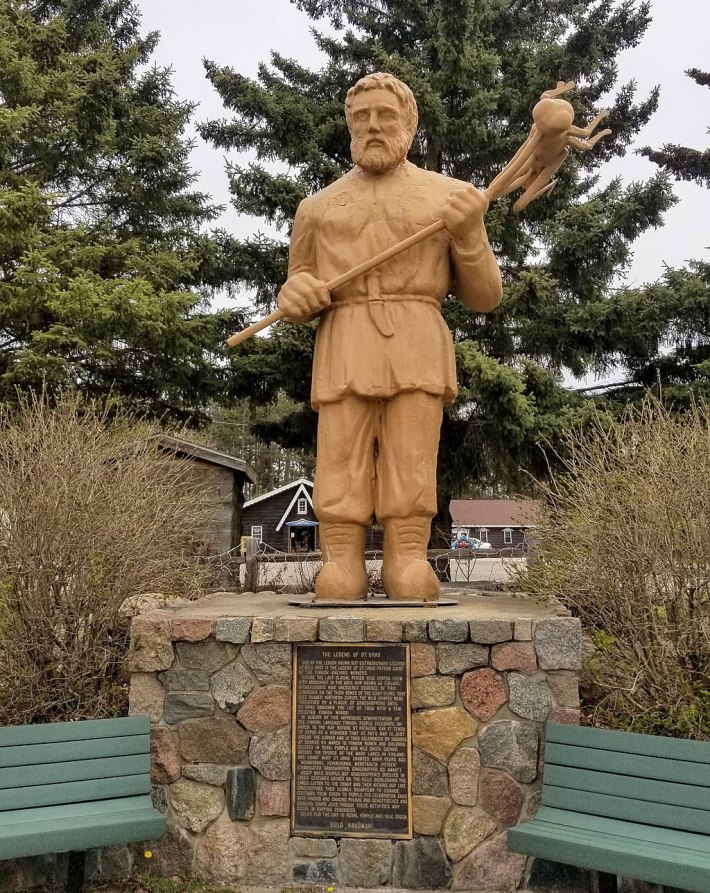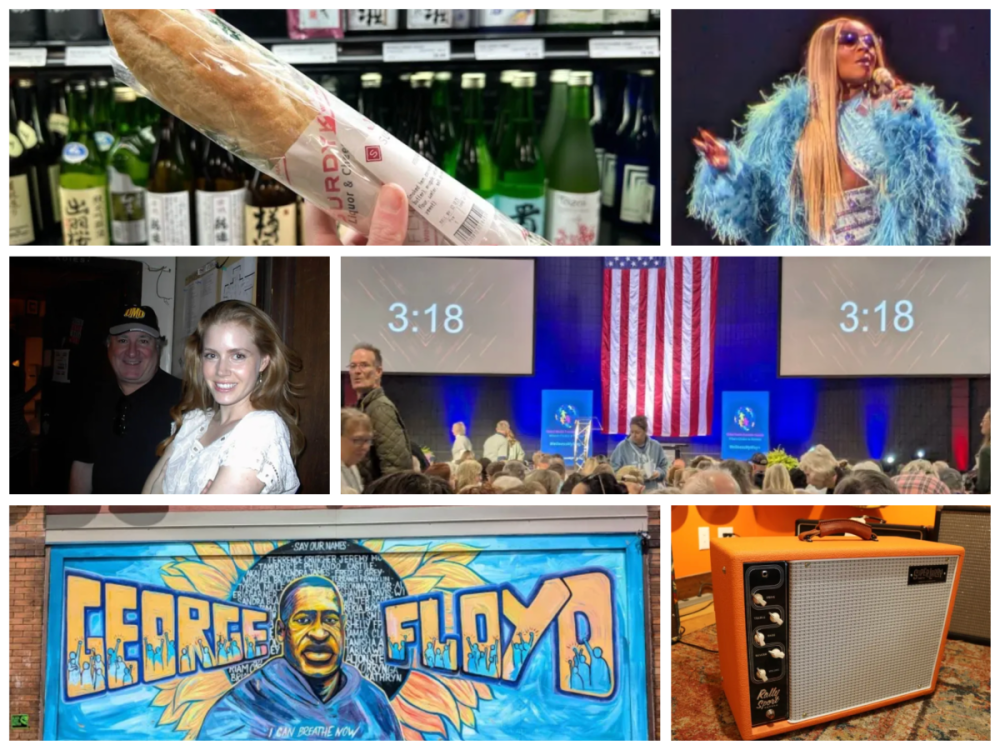As a proud Finnish-American hailing from northern Minnesota, I grew up celebrating St. Urho's Day every March 16. I'd dress in purple to honor the nation's patron saint, who saved its grape crop by chasing the grasshoppers out of Finland. I exchanged St. Urho's Day cards with my friends and called my grandma, who learned Finnish as her first language and has spent years unsuccessfully trying to teach me to pronounce basic phrases (the language is notoriously difficult to learn).
But Finland never had a grape crop, St. Urho didn't exist, and the whole holiday was cooked up in 1956 by Finnish-American Richard L. Mattson, a store manager at Ketola’s Department Store in Virginia, Minnesota. Sulo Havumäki, a Finnish-American professor at Bemidji State College, further developed the myth and created the St. Urho’s Day incantation "Heinäsirkka, heinäsirkka, mene täältä hiiteen" (loosely translated, "Grasshopper, grasshopper, go to hell!”)
Why has this wacky holiday resonated with Finnish-Americans for decades? Although it's culturally and linguistically distinct from Scandinavia, in the U.S., Finland tends to be lumped in with the region, and St. Urho's Day is a way for Finnish-Americans to celebrate our unique heritage. (Minnesota boasts the highest percentage of people with Finnish heritage in the U.S.)
“I think the Finns tend to work hard and then play hard,” says Jan Hillstrom, a committee member for Menahga Civic & Commerce’s annual St. Urho’s Day celebration. Hillstrom is of Finnish descent (99%, according to a DNA test) but didn’t grow up celebrating the holiday, although she was aware of the lore. Menahga’s celebration involves a changing of the guard ceremony in front of the town’s fiberglass statue of St. Urho, who is depicted as stoically impaling a grasshopper on a trident. There’s also a parade with green and purple vehicles, a kids’ pots-and-pans-band, and a literal drill team of people marching with power tools.
“It’s just to rival the Irish and have our own doings,” Hillstrom says. “By the middle of March the people are tired of winter, they need something to liven things up.”

Finland, Minnesota, also hosts an annual St. Urho’s Day Celebration, with a parade that shuts down State Hwy. 1 as the main event. “We do try to maintain the cultural component,” says event coordinator Honor Schauland. “There’s definitely a lot of people around here who are Finnish; I grew up with those people and learned about Finnish culture by association.” In addition to the parade and kids’ activities, this year’s festivities include traditional and contemporary Finnish-American folk music and a community lunch featuring mojakka, a Midwestern Finnish-American soup made with fish (kalamojakka) or beef (lihamojakka).
However, there’s much more to Finnish-American culture—past and present—than St. Urho. The communal sauna experience (and pronouncing the word correctly—it’s “sow-na”, not the Americanized “saw-na”) is an important part of Finnish culture that Finnish-Americans have maintained for generations.
Heather Heffner, who is five-eighths Finnish, remembers family gatherings that included her grandmother’s kalamojakka and sauna: “All the girls would go together, then the boys would go separately together. It was super fun—it felt special, when you’re a little girl and you get to go with the women.”
Another key aspect of Finnish-American culture is the importance of sisu. The word doesn’t have an English equivalent; it’s a combination of toughness, grit, and fortitude. I would define it as being at the end of your rope and facing lousy odds, but persisting anyway. Heffner has a similar definition: “You’re tough, you keep going, you don’t give up.”
Sisu, combined with left-wing political ideology, likely motivated Finnish-American participation in several (often violently suppressed) mining strikes on the Mesabi Iron Range in the late 19th and early 20th centuries. Finnish-Americans were overrepresented in the labor and socialist movements of that era for myriad reasons. They were more likely to work in the dangerous, underregulated lumber and mining industries, experiencing the deadly impact of unfettered capitalism first-hand. Thanks to Finland’s high literacy rates, workers avidly read radical left-wing Finnish-language newspapers and were influenced by socialist and communist ideas. According to Arnold R. Alanen’s Finns in Minnesota, 25-40% of Finnish immigrants were involved in some aspect of leftist political, social, and cultural life, and Finnish-American leftists were instrumental in the formation of Minnesota’s Farmer-Labor Party in the 1930s, a successful timber workers strike in 1937, and the unionization of the state’s mine workers in the late 1930s and early 1940s.
Sisu isn’t only relevant to historical struggles; it’s very much a part of contemporary Finnish-American identity. People get the term emblazoned on mugs, refrigerator magnets, and even themselves. Heffner has the word tattooed on her foot, in honor of her late Finnish-American grandmother.
“I’ve met other people with sisu tattooed on them, and we just start talking, we get excited that we’re both Finnish," she says. "It binds people together still, to know you’ve met another person that's Finnish—there’s a pride there.”
That sense of community existed for past generations of Finnish-Americans, too, and is perhaps best exemplified by the co-op movement. Minnesota’s first Finnish co-op store was founded in Menahga in 1903 as a way to fight back against merchants who price-gouged their rural customers for groceries and other necessities. In addition to the obvious economic incentive, co-ops were appealing to Finnish-American leftists who viewed them as a way to support the labor movement by enabling striking workers to buy goods on credit. By 1917, Finnish-Americans had organized 33 co-op stores in Minnesota as well as the Cooperative Central Exchange, an organization that purchased co-op products in bulk and provided job training. Although most of the original co-ops closed during the latter half of the 20th century due to competition from supermarkets, the Finland Cooperative in Finland, Minnesota, continues to thrive.
Similar to many immigrant cultures, over the decades Finnish-American culture bears less and less resemblance to the Finnish culture it’s derived from and has developed its own traditions and celebrations. Laskiaien, a Finnish sliding festival held at the Loon Lake Community Center in Palo, Minnesota, recently celebrated its 85th year; in addition to an epic sledding hill, the event features traditional artisans, entertainment, a pageant, basketball games, and mojakka. Founded in 1983 with roots in 1970s community celebrations, FinnFest is a multi-day gathering with a marketplace, entertainment, panel discussions, scholarly symposiums, and exhibits. (This year’s event will be held at the Duluth DECC arena from July 26-30.) Twin Cities residents can check out monthly events sponsored by Finnish American Cultural Activities, and Concordia Language Villages offers youth and adult Finnish language programs.
There are many facets to Finnish-American identity, and many ways to celebrate it. Some send group texts on March 16 punctuated with grasshopper and Finnish flag emojis. Many of us are proud of our radical strike-organizing, co-op-founding ancestors. A few get sisu tattoos.
And some pass on our heritage to the next generation of Finnish-Americans, like Heffner hopes to with her one-year-old son.
“I’d like to teach him the words I know in Finn, we’re already teaching him napa, the word for belly button,” she says. “Obviously teach him what sisu means. Once he’s old enough I want to take him to have his first sauna. It’s good to know where you come from and have a sense of pride about that.”







